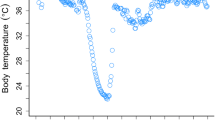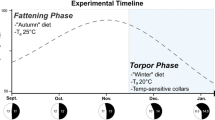Abstract
Ingestion of soft faeces derived from caecal contents, caecotrophy, in herbivorous small mammals is considered an adaptation to the metabolic disadvantage of small body size, especially when feeding on diets of low quality. We investigated daily activity patterns in captive Brandt’s voles (Lasiopodomys brandtii), including feeding, locomotion, caecotrophy, and defaecation, by continuous 24 h visual observation; and estimated the contribution of soft faeces ingestion (caecotrophy) to intake of protein and energy. Brandt’s voles ingested 68.8 ± 7.4 fecal pellets per day, averaging 17 ± 2% of total faeces produced. The amount of faeces ingested did not differ between female and male voles or between night and day time. All animals showed average 3 h ultradian cycles in behaviour during the course of the day and night. The contributions of caecotrophy to the dietary intake of crude protein and metabolizable energy were estimated respectively as 9 and 8% on a high-protein, easily digested commercial rabbit pellet diet. However, the importance of caecotrophy to the field voles is likely to be higher on a natural diet of lower nutrient density. The rhythm of caecotrophy in voles depended mainly on the rhythm of the colonic separation mechanism in the proximal colon and passage in the distal colon, and may be regulated by feeding and other activity rhythms. Ultradian rhythms in caecotrophy helped to minimise potential conflicts in utilizing the gut, especially in balancing the caecal fermentation and salvaging nutrients contained in caecal bacteria.




Similar content being viewed by others
References
Alexander RM (1993) The energetics of coprophagy: a theoretical analysis. J Zool (Lond) 230:629–637
Björnhag G (1987) Comparative aspects of digestion in the hindgut of mammals. The colonic separation mechanism (CSM) (a review). Dtsch Tierärztl Wochenschr 94:33–36
Björnhag G (1994) Adaptation in the large intestine allowing small animals to eat fibrous foods. In: Chivers DJ, Langer P (eds) The digestive system in mammals. Cambridge University Press, Cambridge, pp 287–309
Björnhag G, Sjöblom L (1977) Demonstration of coprophagy in some rodents. Swed J Agric Res 7:105–114
Björnhag G, Snipes RL (1999) Colonic separation mechanisms in lagomorphs and rodent species—a comparison. Mitt Mus Nat kd Berl Zool Reihe 75(2):275–281
Chilcott MJ, Hume ID (1985) Coprophagy and selective retention of fluid digesta: their role in nutrition of the common ringtail possum, Pseudocheirus pereginus. Aust J Zool 33:1–15
Cranford JA, Johnson EO (1989) Effects of coprophagy and diet quality on two microtine rodents (Microtus pensylvanicus and Microtus pinetorum). J Mammal 70:494–502
Daan S, Aschoff J (1981) Short term rhythms in activity. In: Aschoff J (ed) Handbook of neurobiology. Plenum, New York, pp 491–498
Daan S, Slopsema S (1978) Short-term rhythm in foraging behavior of the common vole, Microtus arvalis. J Comp Physiol A 127:215–227
Demment MW, Van Soest PJ (1985) A nutritional explanation for body-size patterns of ruminant and non-ruminant herbivores. Am Nat 125:641–672
Derting TL, Austin MW (1998) Changes in gut capacity with lactation and cold exposure in a species with low rates of energy use, the pine vole (Microtus pinetorum). Physiol Zool 71:611–623
Ebino KY (1993) Studies on coprophagy in experimental animals. Exp Anim 42:1–9
Foley WJ, Cork SJ (1992) Use of fibrous diets by small herbivores: how far can the rules be bent? Trends Ecol Evol 7:159–162
Gross JE, Wang ZW, Wunder BA (1985) Effects of food quality and energy needs: changes in gut morphology and capacity of Microtus ochrogaster. J Mammal 66:661–667
Halle S, Stenseth NC (1994) Microtine ultradian rhythm of activity: an evaluation of different hypotheses on the triggering mechanisms. Mammal Rev 24:17–39
Hammond KA, Wunder BA (1991) The role of diet quality and energy need in the nutritional ecology of a small herbivore, Microtus ochrogaster. Physiol Zool 64:541–567
Hirakawa H (2001) Coprophagy in leporids and other mammalian herbivores. Mammal Rev 31:61–80
Hörnicke H, Björnhag G. (1980) Coprophagy and related strategies for digesta utilization. In: Ruckebusch Y, Thivent P (eds) Digestive physiology and metabolism in ruminants. MTP Press, Lancaster, pp 707–730
Hume ID, Karasov WH, Darken BW (1993) Acetate, butyrate, glucose and proline uptake in the caecum and colon of prairie voles (Microtus ochrogaster). J Exp Biol 176:285–297
Kenagy GJ, Hoyt DF (1980) Reingestion of feces in rodents and its daily rhythmicity. Oecologia 44:403–409
Kenagy GJ, Veloso C, Bozinovic F (1999) Daily rhythms of intake and feces reingestion in the degu, an herbivorous Chilean rodent: optimizing digestion through coprophagy. Physiol Biochem Zool 72:78–86
Keys JE, Van Soest PJ (1970) Digestibility of forages by the meadow vole (Microtus pennsylvanicus). J Dairy Sci 53:1502–1528
Lee WM, Houston DC (1993) The role of coprophagy in digestion in voles (Microtus agrestis and Clethrionomys glareolus). Funct Ecol 7:427–432
Lehmann U (1976) Short-term and circadian rhythms in the behavior of vole, Microtus agrestis. Oecologia 23:185–199
Ouellette DE, Heisinger JF (1980) Reingestion of feces by Microtus pennsylvanicus. J Mammal 61:366–368
Pehrson Å (1983) Caecotrophy in caged mountain hares (Lepus timidus). J Zool (Lond) 199:563–574
Pei YX, Wang DH, Hume ID (2001) Selective digesta retention and coprophagy in Brandt’s vole (Microtus brandti). J Comp Physiol B 171:457–464
Sokolov PG, Bushell WN (1978) The chi square periodogram: its utility for analysis of circadian rhythms. J Theor Biol 72:131–160
Sperber I, Björnhag G, Ridderstrale Y (1983) Function of proximal colon in the lemming and rat. J Agric Res 13:243–256
Stevens CE, Hume ID (1995) Comparative physiology of the vertebrate digestive system. Cambridge University Press, New York
Takahashi T, Sakaguchi E (1998) Behaviors and nutritional importance of coprophagy in captive adult and young nutrias (Myocastor coypus). J Comp Physiol B 168:281–288
Wang DH, Wang ZW, Sun RY (1995) Variations in digestive tract morphology in root vole (Microtus oeconomus) and its adaptive importance. Acta Theriol Sin 15:53–59
Zhang ZB, Wang ZW (1998) Ecology and management of rodent pests in agriculture. Ocean Press, Beijing
Zynel CY, Wunder BA (2002) Limits to food intake by the Prairie vole: effects of time for digestion. Funct Ecol 16:58–66
Acknowledgments
We would like to thank Professor Ian D Hume, Sydney University, Australia, for his constructive comments and suggestions. Thanks to Dr T Derting for reading a draft and improving the English expression. We are grateful to Prof. Göran Björnhag for his suggestions, to Drs Neill Alexander, Zhao-Wen Jiang, and Koichi Ebino for sending us references, and to Dr Menno P. Gerkema for his enthusiastic assistance in estimating the rhythm periods and with some papers. This work was partly supported by grants from the National Natural Science Foundation of China (No. 30430140 and 30170151) to DHW and the CAS Innovative Research International Partnership Project (CXTDS2005-4).
Author information
Authors and Affiliations
Corresponding author
Additional information
Communicated by I.D. Hume.
Rights and permissions
About this article
Cite this article
Liu, QS., Li, JY. & Wang, DH. Ultradian rhythms and the nutritional importance of caecotrophy in captive Brandt’s voles (Lasiopodomys brandtii). J Comp Physiol B 177, 423–432 (2007). https://doi.org/10.1007/s00360-006-0141-4
Received:
Revised:
Accepted:
Published:
Issue Date:
DOI: https://doi.org/10.1007/s00360-006-0141-4




